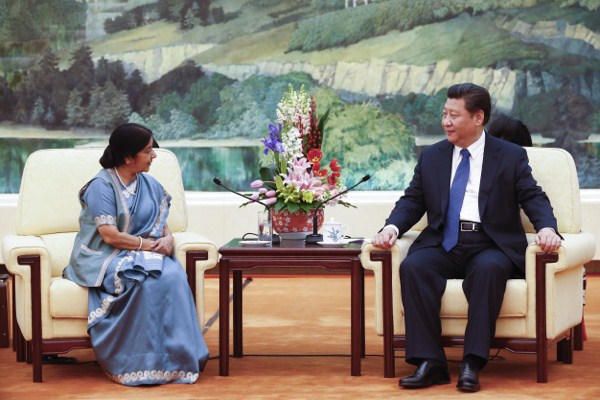China has wasted no time in mounting its own charm offensive to woo India in the aftermath of U.S. President Barack Obama’s visit with Indian Prime Minister Narendra Modi in New Delhi last week. An India Today headline sums it up: “As Modi hugs Obama, China sends a quick flying kiss.” Beijing’s riposte should remind U.S. officials who continue to bank on India’s suspicions of China not to assume that Obama’s trip was sufficient to reset the U.S.-India partnership. China’s reception for Indian External Affairs Minister Sushma Swaraj, who arrived in Beijing this past weekend for consultations with her Russian and Chinese counterparts, sends a clear signal that Chinese President Xi Jinping is determined to chart a new course in relations between “the dragon and the elephant.”
Just as Modi broke with tradition to personally greet Obama at the airport—seen as a not particularly subtle indication of Modi’s interest in getting relations back on track—Xi also dispensed with traditional Chinese diplomatic protocol to receive Swaraj. Generally, visiting foreign ministers have meetings with their counterparts and perhaps the prime minister, with only the representatives of the major powers having the possibility of a direct meeting with the head of state. Having the Chinese president receive the Indian external affairs minister is a recognition of India’s position as one of the great powers, a balance to the American decision to set up a “hotline” between the U.S. and Indian heads of government. Moreover, in the communique of the 13th annual Russia-India-China trilateral meeting, China moved closer to supporting India’s bid for permanent membership on the U.N. Security Council, which, while it does not represent a full endorsement, is a shift from Beijing’s previous full-scale opposition.
Swaraj arrived in Beijing with a six-point action agenda designed to improve the caliber of relations between India and China and so help to usher in the “Asian Century.” Certainly, the United States, as the major power of the Pacific basin, can play a leading role in this process. But while India is happy to have the U.S. as a partner in shifting the focal point of the world from the Euro-Atlantic to the Indo-Pacific theater, it is less interested in serving as America’s western flank in a China containment strategy, unless China poses a threat to Indian interests or security. Indeed, India seems poised to position itself for the role that China itself played 40 years ago during the Cold War—the balancer that retains its own independent freedom of action on the world stage.

